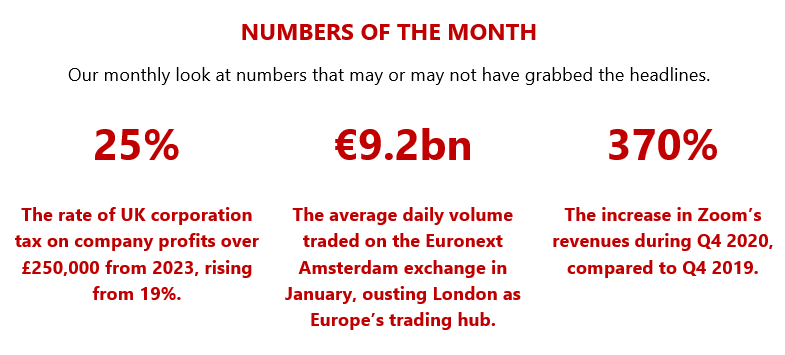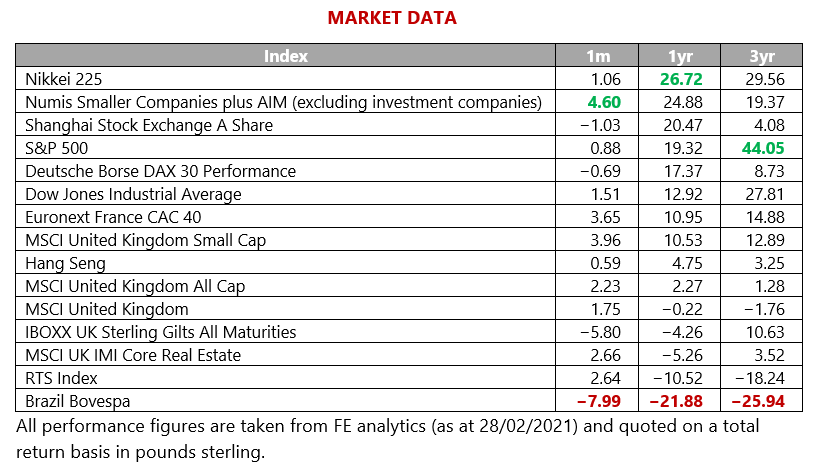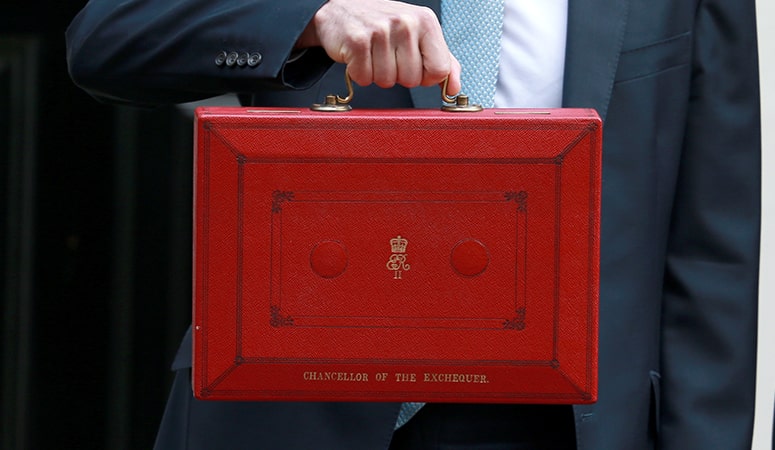The Monthly Market Commentary (MMC), is an update on the world in which we invest. The theme this month is boundaries.
United Kingdom - March 2021
Our theme this month is boundaries. ‘The limit of an area or a dividing line’ is the prime definition here (cricket fans, forgive us, we know there is a MUCH more important meaning, but it just does not fit the narrative this month).
While boundaries do of course follow nature in many cases – rivers, seas and oceans – most are ‘artificial’. We all remember the straight lines of boundaries on our atlas from school days, and the stories of how continents were carved up. Today, we are seeing boundaries around what one might term ‘vaccine nationalism’ – two people, the same age, either side of a border; one gets the vaccine, the other doesn’t. Vaccine tourism is already a ‘thing’ – tens of thousands of Americans have crossed borders (boundaries) to get their shot, including two you may have read about who dressed up as old ladies to try to fool local vaccinators.
Further, there is an issue for the world to consider urgently – how will vaccines get delivered to poorer and/or more remote areas of the world? It is in all of our interests to see Covid-19 vaccinations delivered globally and in a timely fashion. Other boundaries, again, natural ones, are opening up … and this time it is a real mix of bad news and (for some) good.
If vaccine issues are a major social headache, then climate change issues (as described below) remain a massive environmental one, with economic implications (hence the bad news/good news). As the polar ice caps continue to recede at record levels, the Northern Sea Route (NSR) opens up. The NSR is a route between the Atlantic and Pacific oceans, along the Siberian coast and via five seas.
Hampered by ice floes, it is not available all year round, but as climate change has impacted the ice, more vessels traverse the NSR each year and choose it with good reason. It is some 40% shorter than via the Suez Canal (from Northern Europe to China and back) and 60% shorter than going via the Cape of Good Hope.
As the global economy recovers, understanding boundaries (physical, artificial and economic, as well as cultural) will become more and more important for investors. Social and environmental issues must never override good governance; they are increasingly equals, and you will hear more on this from us in these pages in coming months.
The Chancellor’s Budget (delivered 3 March) will be pored over for some time yet. Initial thinking is that it does what Rishi Sunak said it would: it is honest and sets the boundaries/roadmap for the next five years.
It is generally being seen as business positive, though that differs a little depending on whether one is in a freeport area, or outwith those boundaries – certainly the freezing of taxation allowances, while not ideal, is being seen as preferable to hiking tax rates now for individuals, just as so many are struggling to get back on their feet. The UK economy has suffered more than most from the pandemic – it may also recover quickly.
Term or word(s) to watch: supply chain – having written about pent up demand (or the perception of it) last month, time to look at the supply side. A supply chain is usually described as the entire process of making and selling commercial goods, including each stage from the supply of materials and the manufacturing of the goods through to their distribution and sale.
Supply chains can be short distance or long distance. Inditex, the Spanish fashion chain, likes short supply chains because if things are selling in stores, they can get hold of more stock quickly. Other companies have longer supply chains in many cases leading to China, where during the height of the pandemic in Wuhan last year there were problems getting hold of certain raw materials and components, causing disruption. With many manufacturing companies operating ‘just in time’ systems for components it is crucial that parts arrive on time and to the right specification as, for example, closing a car production line can be very expensive.
It is not just Covid-19 that is disrupting supply chains. Brexit disruption at the ports has led to manufacturing delays with lorry drivers getting used to the new paperwork (the non-tariff barriers to trade). However, most companies seem to be coping as they anticipated problems and built up excess stock. Most quoted companies that are reporting their financial results seem to be coping with supply chain issues at the moment and results tend to be coming ahead of (downgraded) expectations across a range of industries, but be wary – as economies reopen, and demand does improve in certain areas, that is when the true tests will come.
North America - March 2021
Stimulus is still the main focus for markets and much of it is already baked into asset prices. The Democrats’ intention to double the minimum wage to $15 an hour has excited a lot of debate – it could be both a positive for economic growth (given the higher propensity to spend from lower earners) but also a headwind because of the additional cost pressures it places on employers. The Senate appears to have thrown a spanner in the works – ruling that a simple majority would not be sufficient to pass the necessary legislation as it could not be tagged onto other budgetary proposals.
This means that 60 votes would need to be registered in favour of the plan – a seemingly unachievable requirement given the composition of the Senate. There were already doubts it would achieve even a simple majority given that some Democrats (those further to the right of the party) have been expressing disquiet over the implications. The Biden administration still has options despite this apparent obstacle – in theory the decision on how the proposal is treated can be overridden (though this is not the administration’s preferred course of action) or, more realistically, it could evolve into a plan to tax corporates who pay less than the $15 level. So it is not off the table yet.
On the subject of legislatures, gerrymandering is the process of drawing, or redrawing, boundaries of an electoral district in order to favour a particular group or party. Often this involves trying to dilute a minority vote, or maximising a particular group’s presence in an area along racial or other grounds.
Bond markets are already moving to reflect the fact that the levels of stimulus injected into the global economy, not least in the US, may well make inflation a threat in a way it has not been for over a decade. Investors are aware that markets are well protected from a sustained downturn by the extraordinary levels of support they are receiving from central banks, but if inflation does become a problem, things could get very interesting. Sure, the Federal Reserve will probably choose to ‘see through’ higher inflation for a period of time, but there will come a point where some sort of response is needed. How the economy, saddled with debt, will cope with this scenario is very uncertain and this will likely lead to volatility.
We have discussed the sustainability of the current shift to more value style names in portfolios and have the option of adjusting the skew of the funds that we choose to use in the US (we actually only employ geographically focused US funds in the most adventurous portfolios). The uncertainty we may shortly be about to face makes a focus on sectoral (thematic) winners the more sensible long-term strategy and we will continue to adopt this approach.
Europe - March 2021
Given the number of countries, Europe always produces lots of news; however, for investors a lot of this is just noise rather than important information. Take France this month, where former Prime Minister Nicolas Sarkozy has been sentenced to jail for corruption and there has been uproar in Lyon where the Green Party Mayor has ordered that just one meat-free meal option be offered in schools. While both are politically interesting, they are neither likely to start a trend of the whole French government being arrested nor a move away from eating meat in the country.
The rollout of the vaccination programme across Europe continues to be more important information, and after a slow start in ordering, it is perhaps no surprise that Europe remains a laggard. Data from the FT suggests that parts of Europe have been very successful, most notably the Nordic countries where Denmark and Sweden are aiming to have inoculated every adult by the end of June. This contrasts to France and Germany, which are sticking to the EU target of vaccinating 70% by the end of September.
Just where are the boundaries of the continent of Europe? Does Europe end on the border with Russia? Or maybe the Ural Mountains? And what of Greenland, which is part of the Kingdom of Denmark? To some geography scholars, the original Latin meaning, deriving from terra continens, means continuous land – so Europe isn’t actually a continent and is part of Eurasia. These scholars would suggest there are only four continents (with Antarctica and Australia just being classed as islands).
Along with the initial rollout problems there have been issues of vaccines not being used in some countries, most notably the AstraZeneca jab in France and Germany. This had been restricted to under 65s due to a lack of data (and poorly reported data when it has been available), which has led to low public opinion and confidence in the jab. Both have now reversed this decision, a climb down from January when President Macron called the jab ‘quasi-ineffective’ for older groups.
Elsewhere, data from Germany showed that share ownership has been rising, with an over 20% increase from last year, to 15% in total. Comparatively this still lags the UK (around 33%) and the US (around 55%) but does demonstrate the need to take more risk given low interest rates and the potential of inflation. Investing in equities has, for many, become necessary rather than just a hobby.
Cutting through the noise of European news, the progress of vaccinating Europe’s population has been mixed meaning Europe is still in the recovery phase economically, rather than returning to growth as the US and UK have. We selectively like European companies rather than the economy and have direct exposure in our higher risk portfolios.
Japan - March 2021
One week ahead of schedule, Japan’s Prime Minister, Yoshihide Suga, lifted the state of emergency in six prefectures (on Sunday, 28 February). The remaining four prefectures still subject to the measures, including Tokyo, will remain that way until 7 March, while an orderly vaccine rollout is well underway with healthcare personnel being prioritised.
These developments have brightened investor sentiment on Japanese equities.
We can now focus on the earnings recovery being relished by many Japanese corporates, as well as longer-term improvements in governance and return on equity.
Indeed, the third-quarter earnings season in Japan surprised to the upside with the manufacturing sector leading the recovery in corporate profits, with technology earnings at all-time highs in many cases. The auto sector too generally positively surprised in terms of cost-cutting measures and operational leverage thanks to the recovery in production volumes. The non-manufacturing sector is more exposed to the negative impact of social distancing measures and is therefore more reliant on a successful vaccination programme allowing a full return to normal life in the latter half of the year.
In an effort to further shake up an insular corporate culture, Japan is proposing further revisions to its corporate governance code. Japan has long been criticised for relatively weak corporate governance that has allowed poor capital allocation to persist within companies. Slowly but surely, however, over the past five years, we have seen a positive change in corporate governance ever since former Prime Minister Shinzo Abe introduced a number of reforms.
Furthering this progress, Ryozo Himino, commissioner of the Financial Services Agency (FSA), has announced a push for listed companies to strengthen their boards with more independent directors. The FSA is proposing a number of revisions to the corporate governance code with a view to strengthen the role of corporate boards, increase diversity within core management and improve disclosures on the environment. Specifically, the FSA will urge companies to allocate a third of board seats to independent directors and aim for a majority of non-executives.
Japan has unique investment opportunities partly because of its distinct culture born of a relatively self-sufficient and insular nature. As an island nation, Japan does not share a land border with any countries making it very much the ‘only child’ of Asia. It does however share maritime borders with the following nations: Taiwan (Republic of China), the Northern Mariana Islands (US territory), the Philippines, Russia, South Korea, China and North Korea.
In comparison to other developed markets, Japanese firms have been relatively successful in maintaining their dividends despite last year’s tumult. We also see early signs that share buybacks are returning to normal levels. This is primarily due to the robust financial position of many Japanese companies.
Overall, companies are in a solid financial position that should enable them to participate in a global recovery as well as future-proofing their businesses by investing in productivity improvements such as IT infrastructure.
We retain exposure to Japanese equities in order to access the outstanding companies that we see flourishing within Japan. We continue to use actively managed funds to differentiate between leading and lagging companies.
Asia Pacific - March 2021
In contrast to the strong initial responses to the Covid-19 virus in many Asian states, vaccination progress has been slow relative to the US and the UK. Asia is the most populous region on the planet, but it accounts for just 40% of the total vaccination doses administered worldwide so far. There are several factors that account for the comparatively slow progress, namely limited vaccine manufacturing capabilities, logistical challenges and regulatory delays. Generally, Asian nations have taken a more cautious approach in approving the use of vaccines relative to the fast-track approach taken by the US and the UK. Indeed, the Chinese government pushed back plans to inoculate 50 million people by the Lunar New Year holiday by two months to the end of March.
Vaccination progress will of course vary across Asian states. Southeast Asian states should receive 695 million vaccine doses by year’s end from COVAX (a joint partnership between the WHO, the Coalition for Epidemic Preparedness Innovations and The Vaccine Alliance), covering roughly half of the region’s population.
According to the Economist Intelligence Unit, widespread vaccine coverage is not anticipated until early 2022 in Singapore closely followed by Vietnam, Thailand and Malaysia. The distribution process is unlikely to be smooth sailing particularly when it comes to accessing remote parts of the region and in storing vaccines in a tropical climate.
Then there are the questions that loom over the safety and efficacy of some locally developed vaccines. The Beijing-based Sinovac vaccine, for instance, has shown an efficacy rate of just over 50% in trials involving high-risk health-care workers. This is far below the 95% success rate recorded for the Pfizer, Moderna and AstraZeneca shots.
Much like the vaccine rollout, economic recovery is likely to be varied across Asia. China, which has successfully stamped out flare-ups with strict local measures, looks to have made a strong early recovery reflected by its 6.5% GDP growth in the final quarter of 2020. ASEAN markets however lagged as they are more sensitive to the tourism industry.
In particular, countries like Singapore and Australia are still grappling with the difficulties of restoring business and leisure travel. Over the long term, these markets are likely to benefit most from a recovery in tourism as vaccinations around the world ramp up. Stocks that stand to benefit the most from the reopening of economies will likely be rotated to, taking from the current winners from Covid-19 restrictions. A move from Northeast Asia to Southeast Asia and from technology and healthcare to cyclical stocks could be on the cards.
Separating Europe and Asia into two distinct continents is not based in geology; instead, it is a historical social construct. Technically, Asia is physically connected to Europe to form the landmass of Eurasia. So, when folk voted to leave the EU … OK, we won’t got there.
We retain a positive long-term view on Asian equities. While the rollout of vaccines over the next few months should help underpin Asian economies’ recovery in the latter half of the year, the region remains poised to benefit from structural growth trends for years to come.
Emerging Markets - March 2021
The relatively rapid recent increase in global bond yields has clearly unnerved those areas of the market that are most dependent on a more risk-on environment, so there has inevitably been some weakness in emerging markets. Not all countries are equally as vulnerable of course, as previous ‘taper tantrums’ have demonstrated. Those running significant current account deficits and with high external debt financing requirements usually run into the most trouble.
Step forward then Turkey, Brazil and South Africa, who have seen their currencies hit hard over the last few weeks. Other areas that are most likely to be affected are the higher yielding currency countries, as rising US bond yields remove the relative attractiveness of these markets.
Any inflationary pressures that build in the global economy could pose specific problems for a number of nations. If central banks are forced to raise rates to combat rising prices, there is the very real prospect of weaker economies being dragged back into recessionary conditions.
That’s the negative stuff over with. Long term, there remain some excellent opportunities in emerging markets that, as a whole, look cheap compared with developed peers. Within emerging markets the value style, as elsewhere, continues to be very lowly rated compared with growth names. For those able to ride out shorter-term movements and uncertainties, this means they present interesting opportunities.
We already have significant China and India exposure, so it is important that where we do have additional emerging market holdings, these are offering something beyond mere duplication.
It is a difficult universe, one of the reasons we adopt a focused approach rather than a general one, but the long-term growth prospects of some of the Southeast Asian countries look very strong (though valuations in many areas already reflect this). Then of course there are the idiosyncratic opportunities presented by even less established frontier markets, which also merit attention.
Is it even appropriate to have an approach to emerging markets investing that is rooted in geographical boundaries? Could the objective not be better achieved by investing in themes and companies whose fortunes are determined by those of emerging markets rather than necessarily being listed/located in them? Possibly, though to obtain a meaningful overall allocation to a country in a portfolio, it can often still be necessary to focus on a more traditional geographical approach, at least in part.
Emerging markets look interesting on a long-term view, but the volatility that lies ahead (as clarification is sought over the prospects for inflation and bond yields) means that the path will be uneven. Some exposure is essential in portfolios, but even better entry points may present themselves for investors over the course of the year.
Spotlight on: Identifying Themes - March 2021
Those who have followed us or been invested with us for a while, will know that we have been increasing our allocations to thematic investments over the last decade. This has been driven by our concerns about lower returns for equities, meaning the traditional geographical approach is no longer always appropriate. The most prominent examples in portfolios are healthcare – given ageing populations and the desire to improve effectiveness of treatments – and technology – given the disruptive potential. But how do we decide what constitutes a theme and what does not? In this month’s spotlight, we look at an idea we had last year, which we ultimately chose not to follow up.
We identified that pets might be an interesting theme in July last year, with pet ownership statistics catching our attention. In the US, 67% of households own a pet, up from 56% in 1998, which is more than households with children.
The attitudes to pet ownership have also been changing with pet welfare having come a long way over the last 50 years from having animals in the yard to them being almost fully fledged family members. This comes with a higher spend, with many surveys suggesting that owners care for their pets like children. A 2017 survey suggested 46% of owners have purchased clothing or fashion accessories for their pets.
While we liked the story, our further investigation discovered that this was not investable. There are a number of listed firms that are involved purely in pet products or services, with the estimated split of these being 50% pet health, 30% retailers and 20% pet foods. This was however quite a narrow universe of names and also included a number of less pet-focused businesses.
Online retailers such as Amazon and eBay have been beneficiaries of the growing pet economy, but sales relating to pets make up relatively small amounts of overall revenue.
When looking for themes, a good story does not always translate into a good investment. Themes also need to be investable, through having enough companies that offer pure access to them. We also consider factors such as valuation and the sustainability of a theme before deciding if it is worth including. With pets, while we were ‘barking up the right tree’, ultimately it was not a theme we could directly access, at least not for now. (This being said, we do have exposure indirectly, via our healthcare names and to some retailers through smaller companies allocations.)
Fixed Income- March 2021
With interest rates having been at record lows and inflation prospects anaemic at best for some time, readers can be forgiven for skipping past the Fixed Income section over the past couple of years! However, it suddenly feels like the fixed income market has become a lot more interesting.
Since 2018, yields on US 10-year Treasury bonds (colloquially known as ‘the 10 year’) have been grinding lower. Indeed, over a two-year period, the yield on these instruments fell from 3% to 0.5%. Covid-19 caused a spike in yields, but normal service was resumed soon after and by April, yields were back to pre-pandemic levels.
In August, sentiment appeared to change and, since then, we have seen a strong upward movement in bond yields, with the 10 year now above 1.4%. The reasons behind the move can be broadly traced back to the incredible levels of fiscal stimulus that have been pumped into the global economy. Not only are investors jettisoning Treasuries as part of a bullish move towards equities, but they are also fearful of the impact of inflation on fixed income securities.
As a reminder, inflation erodes the attractiveness of conventional bonds, particularly with yields so low. Even after the meaningful moves in the market over recent months, just 2% of inflation sees investors in 10-year Treasury bonds earning a negative real yield at current levels.
Equity investors are keeping a watchful eye on bond markets too. Higher rates tend to harm growth stocks, whose value is derived from forecasting expected future cash flows and discounting them back to the present day. Higher rates mean a theoretically lower value for these future cash flows and, therefore, tend to weigh on share prices. Even the defensive consumer staples stocks, referred to as bond proxies due to their stable growth and dividend prospects, are not safe. Similar to fixed income instruments, inflation prospects and rising yields reduce the relative attractiveness of these names.
We continue to hold US Treasuries in portfolios, favouring their defensive characteristics and usefulness in portfolio construction. While we are keeping a close eye on the market, there is still plenty of potential for the road to recovery from Covid-19 to remain bumpy and laden with disappointments. If we are right, these bonds should come into their own once more. We are also neutral on the threat of inflation, believing that might be being overplayed right now by some.
Commodities- March 2021
We have decided to make an initial move into the world of hard commodities and are adding exposure with a metals and mining skew for more adventurous investors. It may well be that talk of a commodity super-cycle is too excitable, but the trends in the global economy are sufficient to make us bullish here. The inflation hedging characteristics of the asset class could also prove to be invaluable if some of the developing fears over inflation do materialise.
Of course, the more people look to hedge inflation, the further they drive commodity prices higher, thereby adding to inflation concerns and a vicious cycle develops. This means we can very quickly find ourselves in ‘overshoot territory’ where prices move too far too quickly and become detached from real prospects. Given how widespread the rise has been in commodity prices, some areas may seem to find themselves in this territory quicker than others, but metals appear to be on a firmer footing. Aside from the general, more robust trends in economic growth and inflation expectations, they find themselves in a sweet spot regarding the rollout of green technology and this makes them the most appealing sub-sector of the asset class in our eyes. Supply deficits in some metals, such as copper, are as large as they have been in more than a decade.
A key risk here – and we have to be extra cognisant of what can go wrong, especially with such strong momentum – is that the demand part of the equation weakens. China has a track record of moving to cool down asset bubbles and if it does something like this again, metals will be impacted. If credit conditions in the country tighten, a correction across the commodities complex could be rather steep.
So certainly something to keep an eye on, but for now the positive trend looks firmly established. Everything appears to be aligned for oil as well, with the prospects for a global recovery meaning that demand is outstripping supply in a meaningful way. Some are even calling for the oil price to get back to $100 a barrel. It still looks a bit too much ‘old economy’ for us.
We are adding to metals/mining on the back of our growth expectations and relative value potential if that comes through. There is also a nod to inflation protection. For those who dismiss the prospects for a return of the inflation threat, oil prices are certainly a thought to contend with.
Property- March 2021
Debate over the role that offices play in our working lives has been raging since early on in the pandemic. It has been easy to be negative on the sector’s prospects, with vast swathes of the workforce operating from home. However, some feel that the worst of the pandemic is behind us and are starting to feel a little more positive. CEOs are discussing the future of work with a lot more certainty and it is fair to say that consensus from executives is mixed.
Goldman Sachs CEO, David Solomon, baulked at the idea of making remote working a permanent and widespread feature within his firm when asked in a recent interview. Mr Solomon described working from home as an ‘aberration’ and rejected claims that it is the ‘new normal’ for post-Covid-19 society. His rationale was that being in the office better suited the firm, which he described as having an ‘innovative, collaborative, apprenticeship culture’. One could be forgiven for thinking that those adjectives are more applicable to a tech firm, many of which (somewhat ironically) have taken completely the opposite stance.
In fact, several large tech firms have hailed an era of ‘OOO (out of office) forever’. Early in the pandemic, online sales platform, Shopify, decided to allow all 7,000 members of staff to work from anywhere indefinitely. Some firms are even using their working from home policies to lure employees that are disgruntled with their current employer’s insistence on returning to the office. Companies are also finding that widening the net and being more open to employing people outside of an ordinarily commutable distance is helping them to improve their talent pool.
The desire to return to what many consider to be ‘normal’ is mixed. For Mr Solomon, his desire appears greater than most. Not only does he feel his company’s culture is damaged, but he is missing out on his favourite past time, DJing. It is well documented, that the Goldman Sachs CEO performs under the stage name DJ D-Sol, producing electronic dance music under his label Payback Records.
The Korean border has a demilitarised zone, where military representatives from each side stand face to face. The border features three small blue buildings, known as T1, T2 and T3, which straddle North and South. The buildings operate as a meeting venue for officials and are also a tourist attraction.
We remain cautious on the office sector. Our exposure tends to be to regional offices that we feel may be better protected than those in major city centres. These properties tend to have plenty of parking and are less reliant on public transport, as well as offering shorter commute times. Some question whether businesses may favour more regional offices over a centralised hub in an expensive location, but that remains to be seen. No changes to allocations for now.
Responsible Assets- March 2021
In 1970, the average age of a world leader was 61. Today, this figure stands closer to 65. Perhaps it is fair to argue that increases in life expectancy have a part to play and we are seeing some exciting young politicians rise through the ranks across the world. However, let us not forget that in the last US election, the nation had a choice between Donald Trump and Joe Biden, who were 74 and 78 respectively at the time of the (2021) inauguration. It is not just world leaders that appear to be getting older, CEOs are too. In 2005, the average age of a CEO in the US at hire was 46. Since then, that figure has been steadily rising and was reported to have reached 54 by 2018, a fairly short period over which to see such a significant rise.
The reason this matters is because nations and companies have a great deal of power and influence when it comes to climate change. The majority of firms have set out very ambitious targets, but most reference arbitrary dates in the future (most of which tend to end in a zero or a five) that extend far beyond the tenure of most CEOs. Take BP for example. Their CEO will be well into his eighties by the time verdict can be passed on their target to become carbon neutral by 2050.
While we must applaud the introduction of these well-intentioned targets, questions have to be raised around how motivated present day business leaders are to instigate meaningful change, when many of them are measured almost exclusively on traditional financial metrics. Do they really want to sacrifice hitting their targets on earnings per share to help their successor meet environmental targets that are decades on?
Ultimately, actions speak louder than words. The fear is that the heavy lifting will be left to the leaders of the future, or worse still, targets pushed further out. That is not an approach we are comfortable with, and you will read more from us on the subject in coming months.
Currency- March 2021
You may have heard the term ‘fiat currency’ and wondered quite what it means. Well, you need wonder no more.
A fiat currency is government-issued and not backed by a physical commodity, such as gold, but rather by the government that issued it. The value of fiat money therefore comes from the relationship between supply and demand and the stability of the issuing government (and we would argue central bank) rather than the worth of a commodity backing it. Most modern ‘paper’ (how old fashioned) currencies are fiat currencies, including the US dollar, the euro and the yen, but the US dollar is generally accepted as the world’s fiat currency.
UK Interest Rates- March 2021
So, post-Budget, what (if anything) does Chancellor Sunak’s approach mean for UK interest rates? He majored on the low cost of borrowing during his speech, and the proposed Green Bond (from NS&I, expected in the summer) will undoubtedly play to that – it will have to have a rate that attracts investors (individuals) to deposit funds into it, without having too high a rate to make it ineffective as a source of funding for the government’s intentions.
On balance, sterling was unaffected by the Budget, and we don’t expect the Bank of England to take any action any time soon.


The Monthly Market Commentary (MMC) is written and researched by Simon Gibson, Richard Smith, Scott Bradshaw, Jonathon Marchant and Lauren Wilson for clients and professional connections of Mattioli Woods plc, and is for information purposes only. It is not intended to be an invitation to buy, or to act upon the comments made, and all investment decisions should be taken with advice, given appropriate knowledge of the investor’s circumstances. The value of investments and the income from them can fall as well as rise and investors may not get back the full amount invested. Past performance is not a guide to the future. Mattioli Woods plc is authorised and regulated by the Financial Conduct Authority.
The MMC will always be sent to you by the seventh working day of each month, usually sooner, is normally delivered via email, and is free of charge as the MMC is generally made available to clients who have assets under our management in excess of £200,000, and to all clients under our Discretionary Portfolio Management Service (DPM). Normally, the MMC costs £397 + VAT per annum. Professional advisers and their clients should contact us if they are interested in receiving a monthly copy.
Sources:
www.bbc.co.uk, www.bloomberg.com,
Financial Express, www.thedragonsblade.com,
www.express.co.uk,
www.pitstoppin.co.uk,
www.sibcyclinenews.com,
www.vr-12.com,
www.smalltalkbigresults.wordpress.com,
www.mmn.com,
www.avantida.com,
www.plazmedia.com,
www.viewzone.com,
www.anonw.wordpress.com.
All other sources quoted if used directly; except fund managers who will be left anonymous; otherwise, this is the work of Mattioli Woods plc.





